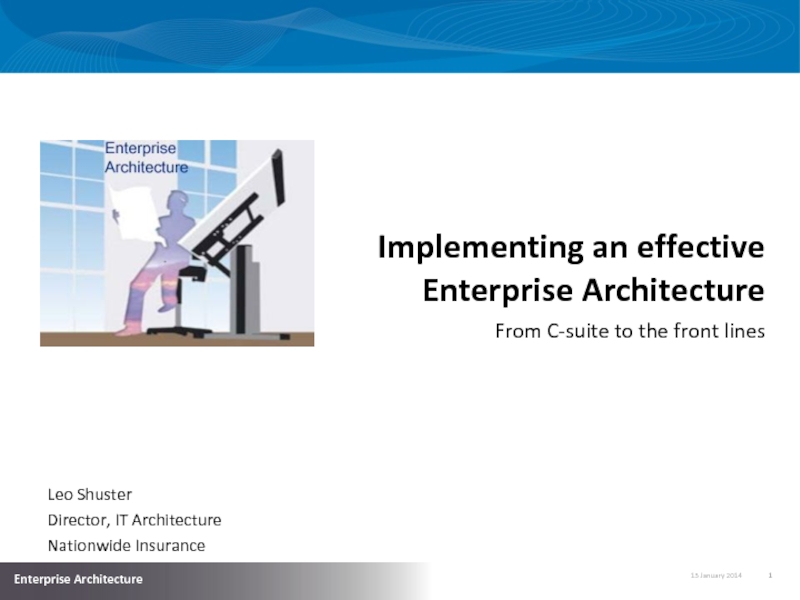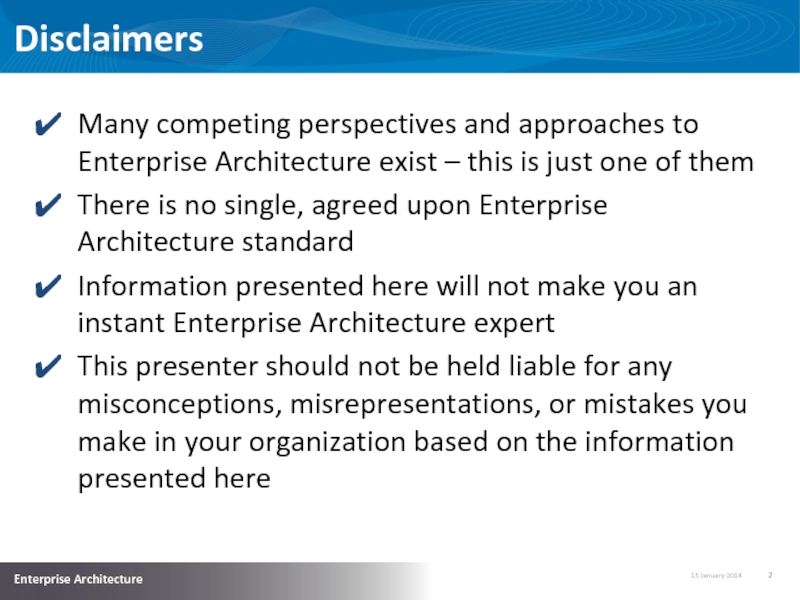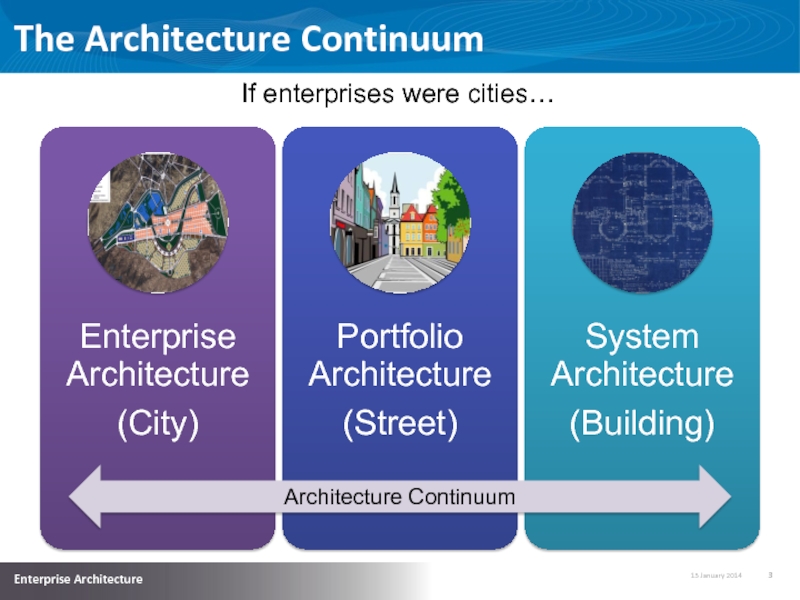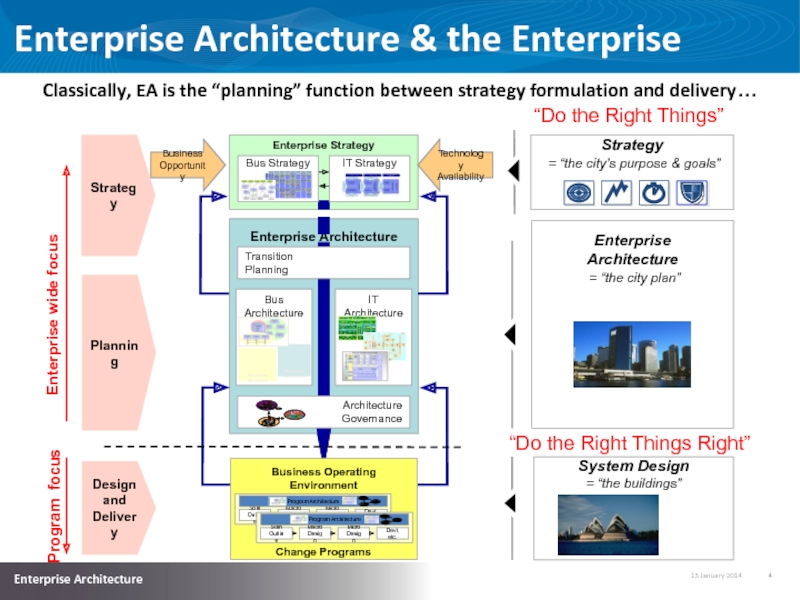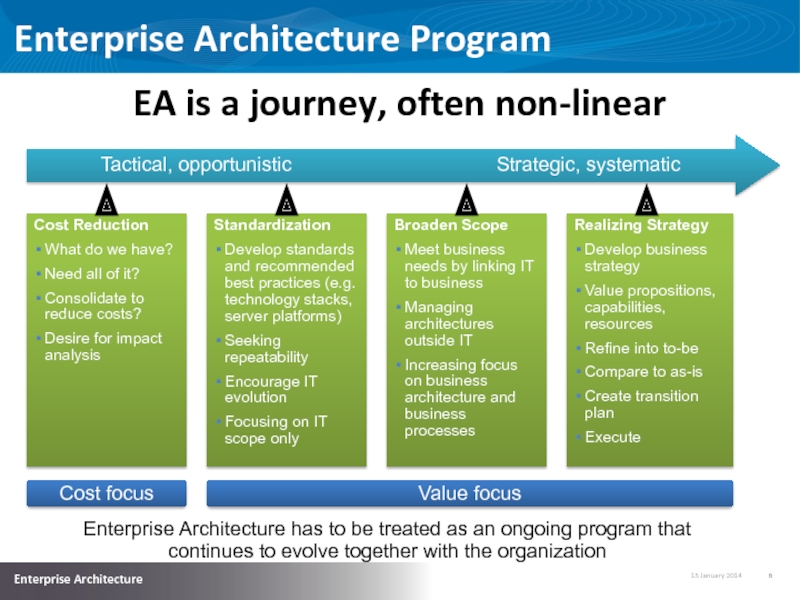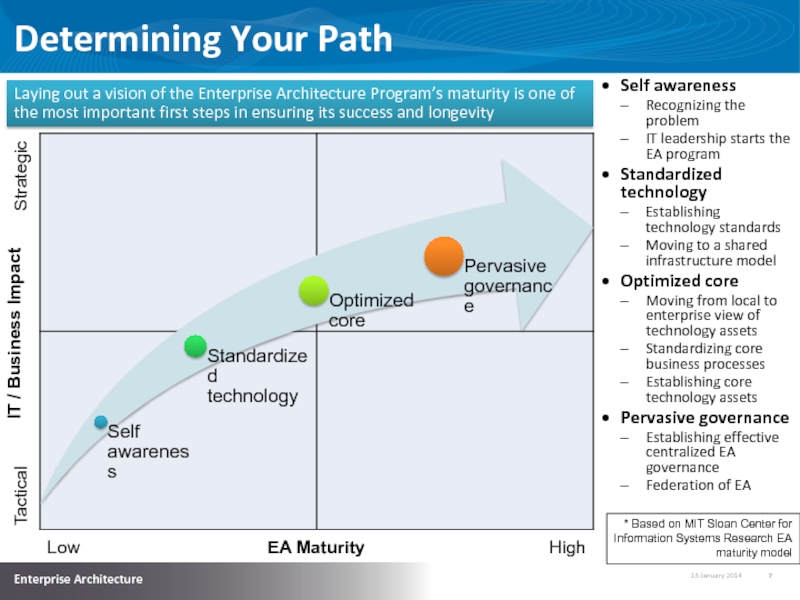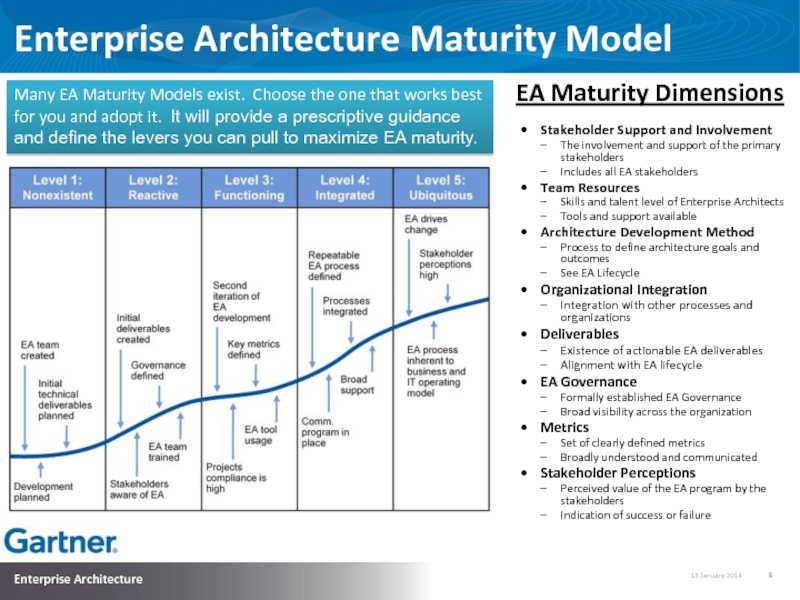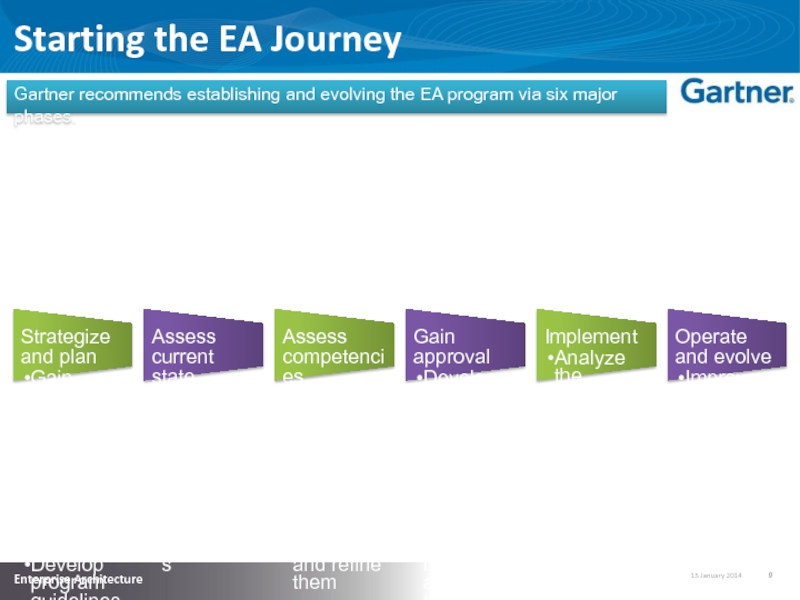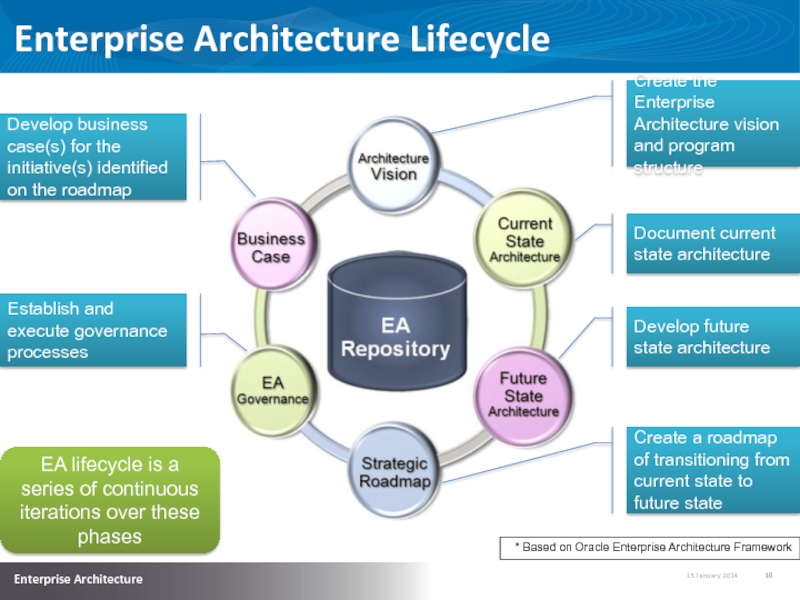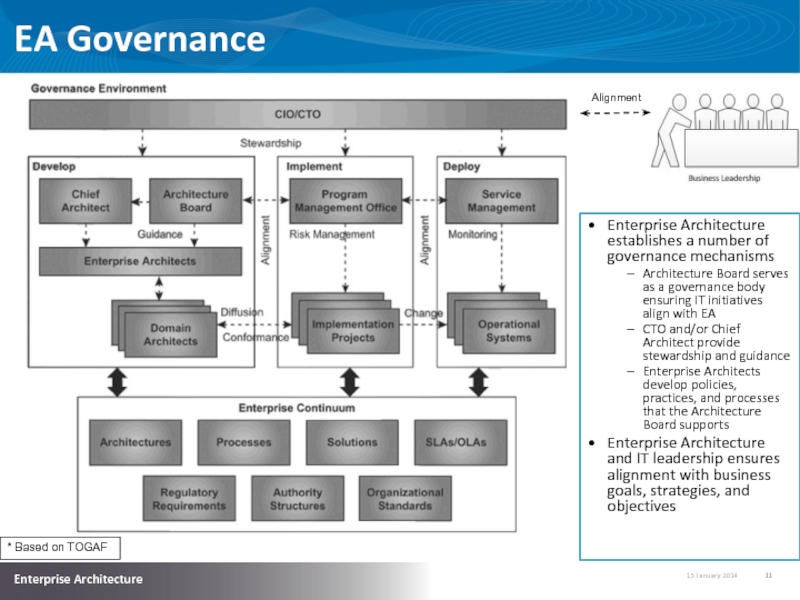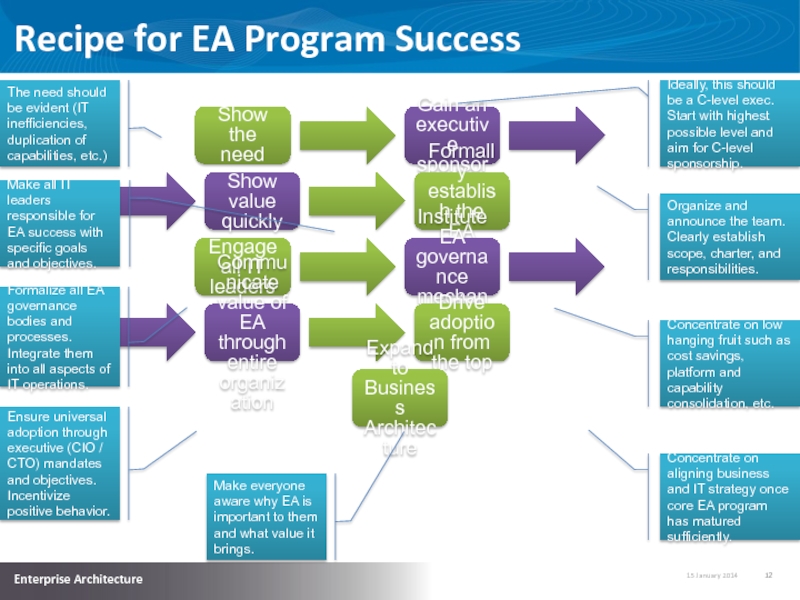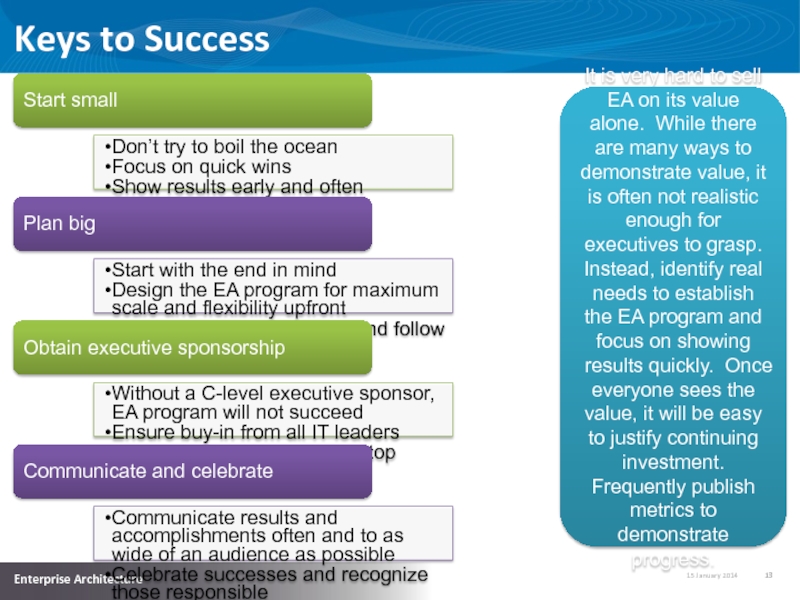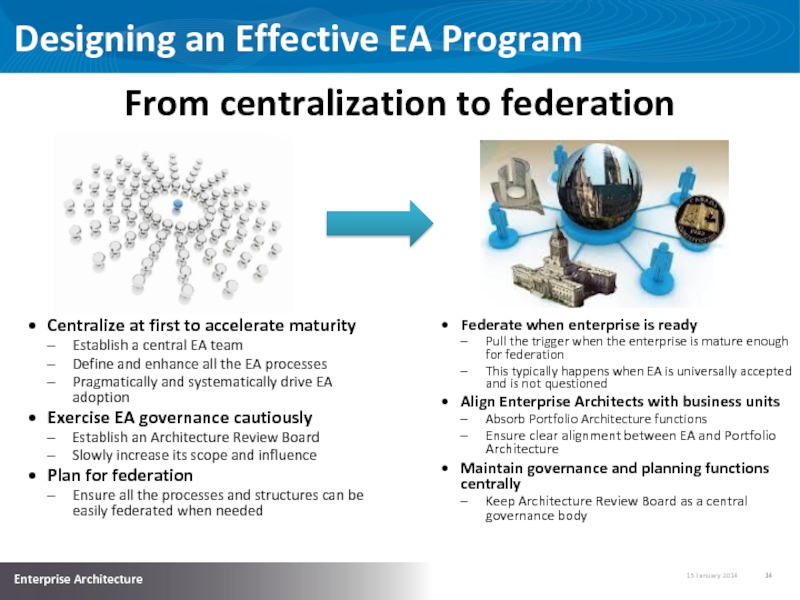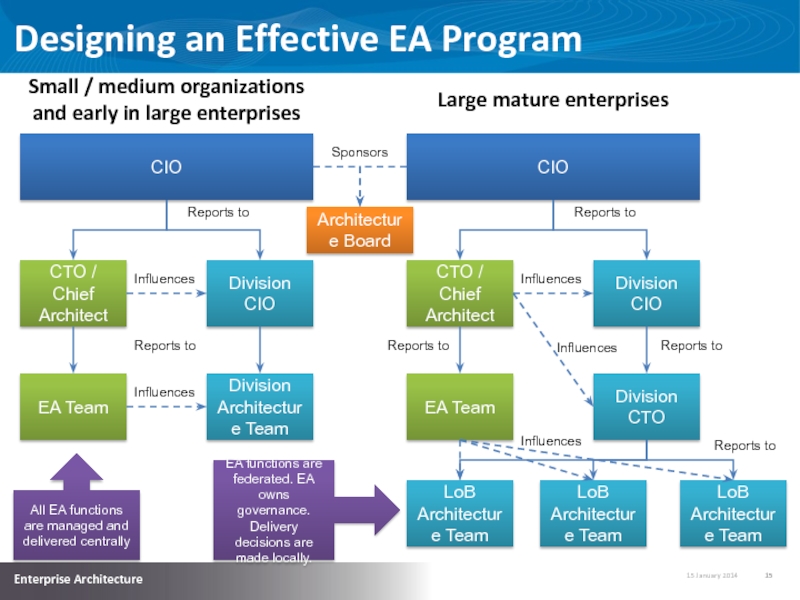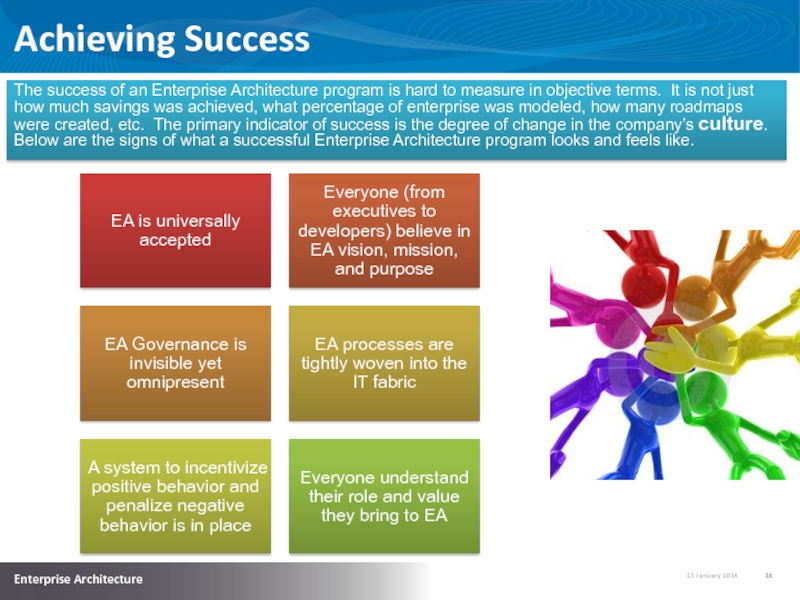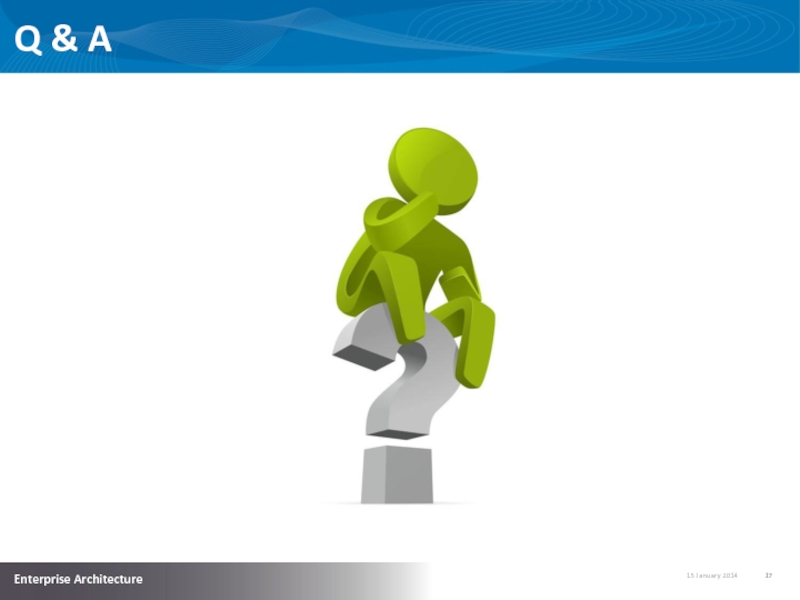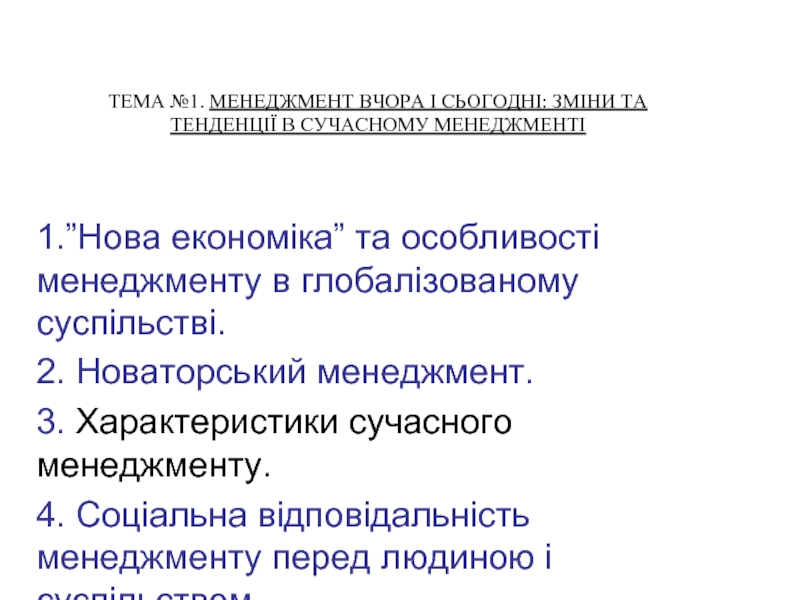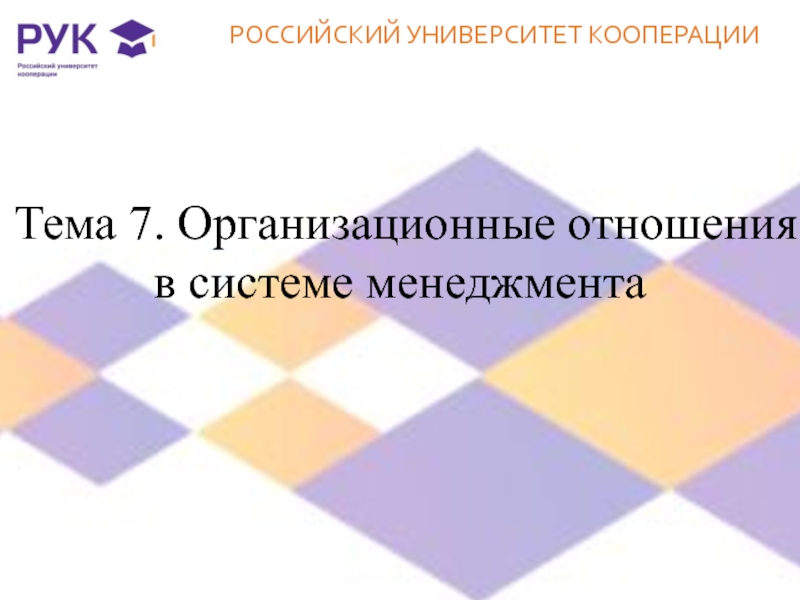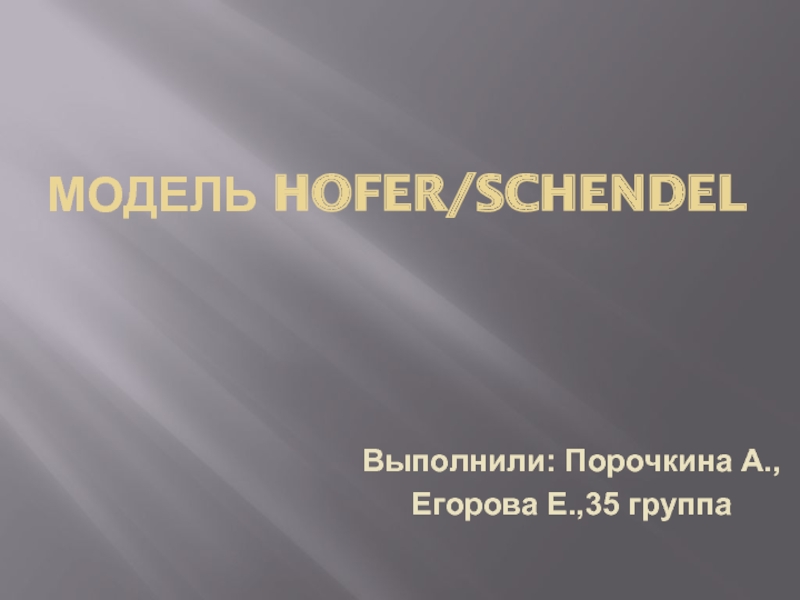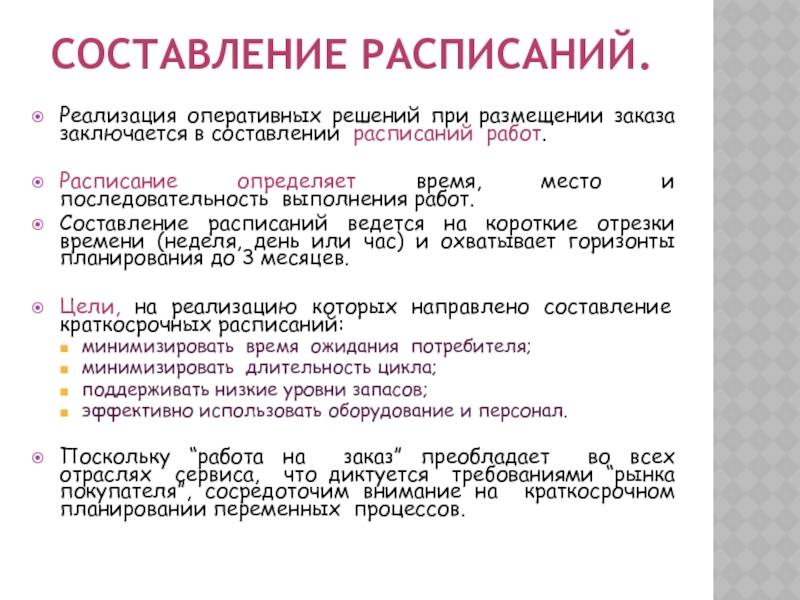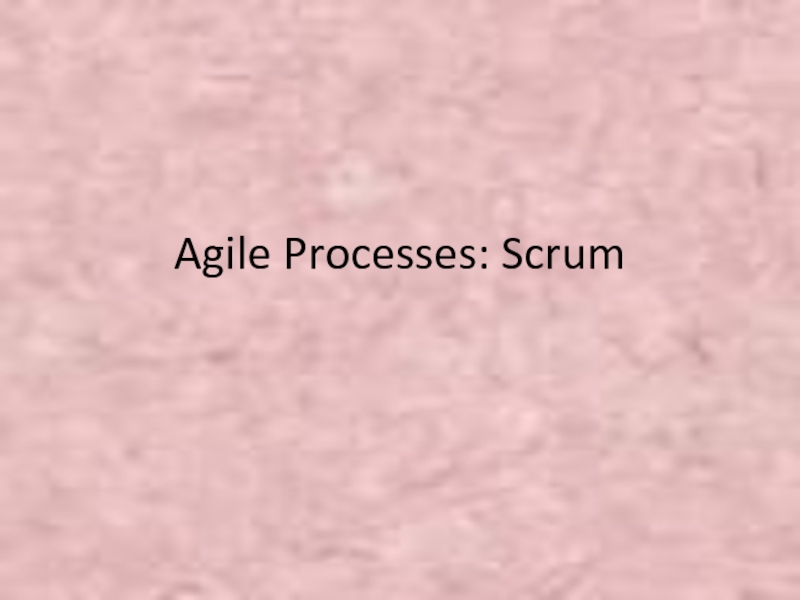- Главная
- Разное
- Дизайн
- Бизнес и предпринимательство
- Аналитика
- Образование
- Развлечения
- Красота и здоровье
- Финансы
- Государство
- Путешествия
- Спорт
- Недвижимость
- Армия
- Графика
- Культурология
- Еда и кулинария
- Лингвистика
- Английский язык
- Астрономия
- Алгебра
- Биология
- География
- Детские презентации
- Информатика
- История
- Литература
- Маркетинг
- Математика
- Медицина
- Менеджмент
- Музыка
- МХК
- Немецкий язык
- ОБЖ
- Обществознание
- Окружающий мир
- Педагогика
- Русский язык
- Технология
- Физика
- Философия
- Химия
- Шаблоны, картинки для презентаций
- Экология
- Экономика
- Юриспруденция
Implementing an effective Enterprise Architecture презентация
Содержание
- 1. Implementing an effective Enterprise Architecture
- 2. Disclaimers Many competing perspectives and approaches to
- 3. The Architecture Continuum If enterprises were cities… Architecture Continuum
- 4. Enterprise Architecture & the Enterprise Enterprise
- 5. What is Enterprise Architecture? Simple definition: Enterprise
- 6. Enterprise Architecture Program Cost focus Value focus
- 7. Determining Your Path EA Maturity Low High
- 8. Enterprise Architecture Maturity Model Stakeholder Support and
- 9. Starting the EA Journey Strategize and
- 10. Enterprise Architecture Lifecycle Create the Enterprise Architecture
- 11. EA Governance * Based on TOGAF Alignment
- 12. Recipe for EA Program Success Show the
- 13. Keys to Success Start small Don’t try
- 14. Designing an Effective EA Program From centralization
- 15. Designing an Effective EA Program CIO CTO
- 16. Achieving Success The success of an Enterprise
- 17. Q & A
- 18. About the Author
Слайд 1Implementing an effective Enterprise Architecture
From C-suite to the front lines
Leo Shuster
Director,
Nationwide Insurance
Слайд 2Disclaimers
Many competing perspectives and approaches to Enterprise Architecture exist – this
There is no single, agreed upon Enterprise Architecture standard
Information presented here will not make you an instant Enterprise Architecture expert
This presenter should not be held liable for any misconceptions, misrepresentations, or mistakes you make in your organization based on the information presented here
Слайд 4Enterprise Architecture & the Enterprise
Enterprise Strategy
Fire and hope!
Business Operating Environment
and IT
Classically, EA is the “planning” function between strategy formulation and delivery…
“Do the Right Things”
“Do the Right Things Right”
Слайд 5What is Enterprise Architecture?
Simple definition:
Enterprise Architecture is a strategy to minimize
Слайд 6Enterprise Architecture Program
Cost focus
Value focus
EA is a journey, often non-linear
Tactical,
Cost Reduction
What do we have?
Need all of it?
Consolidate to reduce costs?
Desire for impact analysis
Standardization
Develop standards and recommended best practices (e.g. technology stacks, server platforms)
Seeking repeatability
Encourage IT evolution
Focusing on IT scope only
Broaden Scope
Meet business needs by linking IT to business
Managing architectures outside IT
Increasing focus on business architecture and business processes
Realizing Strategy
Develop business strategy
Value propositions, capabilities, resources
Refine into to-be
Compare to as-is
Create transition plan
Execute
Enterprise Architecture has to be treated as an ongoing program that continues to evolve together with the organization
Слайд 7Determining Your Path
EA Maturity
Low
High
Strategic
Tactical
IT / Business Impact
Laying out a vision of
* Based on MIT Sloan Center for Information Systems Research EA maturity model
Self awareness
Recognizing the problem
IT leadership starts the EA program
Standardized technology
Establishing technology standards
Moving to a shared infrastructure model
Optimized core
Moving from local to enterprise view of technology assets
Standardizing core business processes
Establishing core technology assets
Pervasive governance
Establishing effective centralized EA governance
Federation of EA
Слайд 8Enterprise Architecture Maturity Model
Stakeholder Support and Involvement
The involvement and support of
Includes all EA stakeholders
Team Resources
Skills and talent level of Enterprise Architects
Tools and support available
Architecture Development Method
Process to define architecture goals and outcomes
See EA Lifecycle
Organizational Integration
Integration with other processes and organizations
Deliverables
Existence of actionable EA deliverables
Alignment with EA lifecycle
EA Governance
Formally established EA Governance
Broad visibility across the organization
Metrics
Set of clearly defined metrics
Broadly understood and communicated
Stakeholder Perceptions
Perceived value of the EA program by the stakeholders
Indication of success or failure
Many EA Maturity Models exist. Choose the one that works best for you and adopt it. It will provide a prescriptive guidance and define the levers you can pull to maximize EA maturity.
EA Maturity Dimensions
Слайд 9Starting the EA Journey
Strategize and plan
Gain agreement on the major problems
Charter the EA program
Develop program guidelines
Assess current state
Identify current level of organizational maturity
Understand existing capabilities
Assess competencies
Identify EA requirements
Review established budgetary practices and refine them
Gain approval
Develop a formal plan
Perform a strategic planning exercise
Develop the requirements, and assess the results
Implement
Analyze the findings and prioritize the gaps
Develop investment plans using identified business cases
Present findings to gain funding and approval
Operate and evolve
Improve and refine your efforts
Continue evolving future state plans
Gartner recommends establishing and evolving the EA program via six major phases.
Слайд 10Enterprise Architecture Lifecycle
Create the Enterprise Architecture vision and program structure
Document current
Develop future state architecture
Create a roadmap of transitioning from current state to future state
Establish and execute governance processes
Develop business case(s) for the initiative(s) identified on the roadmap
EA lifecycle is a series of continuous iterations over these phases
* Based on Oracle Enterprise Architecture Framework
Слайд 11EA Governance
* Based on TOGAF
Alignment
Enterprise Architecture establishes a number of governance
Architecture Board serves as a governance body ensuring IT initiatives align with EA
CTO and/or Chief Architect provide stewardship and guidance
Enterprise Architects develop policies, practices, and processes that the Architecture Board supports
Enterprise Architecture and IT leadership ensures alignment with business goals, strategies, and objectives
Слайд 12Recipe for EA Program Success
Show the need
Gain an executive sponsor
Formally establish
Show value quickly
Engage all IT leaders
Institute EA governance mechanisms
Drive adoption from the top
Communicate value of EA through entire organization
Expand to Business Architecture
The need should be evident (IT inefficiencies, duplication of capabilities, etc.)
Ideally, this should be a C-level exec. Start with highest possible level and aim for C-level sponsorship.
Organize and announce the team. Clearly establish scope, charter, and responsibilities.
Concentrate on low hanging fruit such as cost savings, platform and capability consolidation, etc.
Make all IT leaders responsible for EA success with specific goals and objectives.
Formalize all EA governance bodies and processes. Integrate them into all aspects of IT operations.
Ensure universal adoption through executive (CIO / CTO) mandates and objectives. Incentivize positive behavior.
Make everyone aware why EA is important to them and what value it brings.
Concentrate on aligning business and IT strategy once core EA program has matured sufficiently.
Слайд 13Keys to Success
Start small
Don’t try to boil the ocean
Focus on quick
Show results early and often
Plan big
Start with the end in mind
Design the EA program for maximum scale and flexibility upfront
Create a maturity roadmap and follow it
Obtain executive sponsorship
Without a C-level executive sponsor, EA program will not succeed
Ensure buy-in from all IT leaders
Drive adoption from the very top
Communicate and celebrate
Communicate results and accomplishments often and to as wide of an audience as possible
Celebrate successes and recognize those responsible
It is very hard to sell EA on its value alone. While there are many ways to demonstrate value, it is often not realistic enough for executives to grasp. Instead, identify real needs to establish the EA program and focus on showing results quickly. Once everyone sees the value, it will be easy to justify continuing investment. Frequently publish metrics to demonstrate progress.
Слайд 14Designing an Effective EA Program
From centralization to federation
Centralize at first
Establish a central EA team
Define and enhance all the EA processes
Pragmatically and systematically drive EA adoption
Exercise EA governance cautiously
Establish an Architecture Review Board
Slowly increase its scope and influence
Plan for federation
Ensure all the processes and structures can be easily federated when needed
Federate when enterprise is ready
Pull the trigger when the enterprise is mature enough for federation
This typically happens when EA is universally accepted and is not questioned
Align Enterprise Architects with business units
Absorb Portfolio Architecture functions
Ensure clear alignment between EA and Portfolio Architecture
Maintain governance and planning functions centrally
Keep Architecture Review Board as a central governance body
Слайд 15Designing an Effective EA Program
CIO
CTO / Chief Architect
EA Team
Division CIO
Division Architecture
Reports to
Small / medium organizations and early in large enterprises
Influences
Influences
Reports to
CIO
CTO / Chief Architect
EA Team
Division CIO
Division CTO
Reports to
Large mature enterprises
Influences
Influences
Reports to
LoB Architecture Team
Reports to
LoB Architecture Team
LoB Architecture Team
Reports to
Influences
All EA functions are managed and delivered centrally
EA functions are federated. EA owns governance. Delivery decisions are made locally.
Architecture Board
Sponsors
